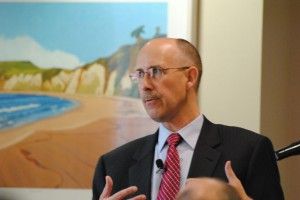In the wake of a national conversation about gun control and mental illness, Dr. Gene Deisinger addressed an audience containing DPS officers, International Programs staff and directors at the Disability Services Office Tuesday afternoon on campus safety in higher education.
“You’ve heard I’m both a clinical psychologist and a cop,” Deisinger said jokingly. “When people engage in criminal acts, I get to arrest them and then ask them how they feel about it afterwards.”
Deisinger is one of the nation’s experts on threat assessment and campus safety, and is a regular consultant to university administrators and Public Safety officials. He is the Chief Security Officer at Virginia Tech University and a managing partner for Sigma Threat Management Associates.

After the fall
“A month ago our nation was shattered,” Deisinger said in the meeting. “We had another mass tragedy incident in Newtown, Conn. when the unthinkable occurred in front of us all — that someone could go into a grade school and massacre a group of first graders. It is seemingly beyond comprehension until, of course, it happens.
“But isn’t that our reaction after each and every one of these? We are startled and shocked to the core of the new ways we as human beings can impart pain and damage upon our community.”
Deisinger’s primary objective was to inform Pepperdine safety leaders in threat management and safety procedure, but he insisted that while mass casualties are tragic, they should not be the primary engine for policy and procedure reform.
“It is important that we learn from the lessons and the tragedies of Sandy Hook, Aurora, Tuscon and Virginia Tech and on and on,” Deisinger said. “My concern is that we enact policies and practices based on singular and unique circumstances. I think it’s important that we keep a broad spectrum and understanding of what we’re learning from these incidents, and what we can use to enhance the safety and well-being of our community.”
Public misinformation surrounding mass casualties in higher education is a large part of the issue, Deisinger said.
“The media gets this wrong a lot,” Deisinger said. “Mass violence in higher education is not a new phenomenon. It has been going on since the dawn of higher education. The change is the number of casualties.”
By the numbers
In an interview before the event, Deisinger advocated against the use of statistics as a way to measure the success of a public safety department or police force.
“The thing to be careful about with statistics is that statistics are generalizations about groups of people or groups of circumstances or groups of behaviors,” Deisinger said. “We like to boil things down to the numbers, and it’s sometimes easy to lose sight of the fact that the numbers are simply shorthand for much more complex and nuanced realities.”
Furthermore, many of the popular beliefs on the causes of crime do not reflect the reality of crime prevention, Deisinger said.
“The number of officers, except in the case of assault crimes, is not a significant factor in the deterrence or intervention of crime,” Deisinger said. “There is some data that suggests that a high visibility and presence of security officers does decrease the likelihood of physical assaults, but it has minimal effect on sexual assault.”
Deisinger went on to say that alcohol is present in the majority of reported crimes for both the victim and the perpetrator. He noted, however, that alcohol correlates with crime, but does not necessarily have a causative relationship.
Moving forward
Law enforcement officials across the country are coming together to tackle the culture of violence in America, Deisinger said.
“We’re finding that more recent incidents, in particular Sandy Hook, have been a galvanizing experience for public safety agencies across the United States of asking the question of whether traditional law enforcement approaches are sufficient to mitigate risk and protect specialized communities like elementary schools and houses of worship,” Deisinger said.
While this may be true, Deisinger said he is frustrated by the widespread criticism of law enforcement without providing any real alternatives.
“One of my criticisms of North American culture is that we are really good at criticizing what somebody else did or failed to do,” Deisinger said.
“What we’re not very good at is celebrating all that people did do to prevent loss of life, to mitigate harm that was already occurring and to help a devastating community through a horrible time.”

